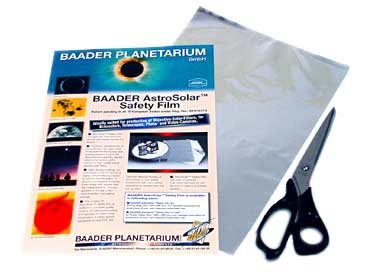patented Baader AstroSolar® Safety Film
The below information are valid for all three AstroSolar® Films as well as Baader TurboFilm™ (TurboFilm™ solely serves to protect your optics and is not suited for Solar observation/photography):
Optical quality:
This highest precision film consistently produces strehl ratios of 94 to 96 percent at interferometric tests – thus it performs optically like a Fluorite Triplet Lens by Carl Zeiss or Astro Physics (Interferometric test results). Unfortunately we have a hard time ourselves to see any difference in performance between AstroSolar® and 1/20 wave precision optical windows which we were stocking from Zeiss. Our stock of precision polished plates ran into tens of thousands of $ – all stocked in for the 1999 eclipse – but AstroSolar® was so good in fact, that these plates were hard to sell. Our Safety Film shows notably more sharpness and contrast than any competitive product we know of, especially including all affordable US-Glass Objective Filters.
What is even more important – with AstroSolar® the Sun appears in it’ s real color – neutral white. Other films and most glass filters produce a blurry bluish or reddish Solar image, thereby cutting part of the spectrum. Especially with an orange sun, it is very hard to see faculae regions which are visible predominantly in the blue wing of the spectrum.
Due to it’s neutral color balance, AstroSolar® enables the use of various color (or interference) filters which allows the observer to concentrate on certain spectral passbands for investigations of different layers within the solar “atmosphere”.
Baader Planetarium’s AstroSolar® Film and TurboFilm™ is a specially manufactured streak- and blister-free film which is only 0.010 mm thick and attains the optical quality of plane-parallel glass filters. The base material is not “Mylar”. The highly uniform molecular structure of this material is the result of demands in nuclear- and elementary-particle physics.
Eye safety:
AstroSolar® is essentially free of pinholes, since – other than with even the most expensive glass filters – it is coated on both sides, so that the chance of two pinholes overlapping each other is extremely faint. Pinholes do appear, but to 1 out of 10000 only in optical density 2.5! All processes connected to this product have been thoroughly tested. Coatings are inspected constantly for consistency to ensure your eye safety! AstroSolar® Photo Film 3.8 and Baader TurboFilm™ must not be used for visual observation.
History and goal of AstroSolar®:
Baader Planetarium delivered solar safety film for 20million eclipse viewers that were used throughout Europe for the 1999 Eclipse. Not one user of our films has suffered from eye damage. We produce solar safety films for over 25years and have reason to claim a high degree of competence for all aspects of solar observation. With Baader AstroSolar® we are set out to show you the Sun’s hidden grandeur at a fraction of the cost of comparable equipment. Real professional solar work was always restricted to a few hardnecked amateurs who would put up to $1000,- or more for a real precision 1/20 wave glass filter or 2″ Herschel wedge. Now you can get an equally precise AstroSolar® filter to fit an 8″ aperture for $ 30,- (or much less even, if a whole group of people shares a larger roll of 100×50 cm size film). Not longer will solar observation be a “so la la” experience, where you look into your telescope through an “economy priced” glass filter and wonder what this kind of amateur activity is all about. AstroSolar® Film offers a crisp and esthetic solar image. The telescope offers the same performance during the day that it has at night. Always we were amazed how easily amateurs would accept mediocre sharpness during observation of our nearest star, while they can be extremely critical if the telescope would not perform perfect on other stars.
Production:
The development of AstroSolar® was only possible due to the increadible demand during the 1999 eclipse. Dozens of miles of film were destroyed during tests to produce the tooling and process techniques to receive an absolutely uniform molecular structure for the substrate. Not to speak of the related treatments, annealing and dual side coating that the film undergoes until it has attained the desired properties. In essence we can offer you two film products which do not at all distort the performance of your telescope;
1. AstroSolar® for solar observation and photography (see “Differences of AstroSolar Films“),
2. TurboFilm™, as night time protection of your valuable optical equipment; to shield it against dirt, scratches , coating defects, humidity inside open tubes and on mirror surfaces – and last not least, to stop air currents (tube-seeing). Not suitable for solar observation / photography

In case of OD 5.0 and solar photography, is this type of filter compatible with large Diameter Schmidt Cassegrain Télescope (> 8″) without IR-Cut filter before the camera ? In fact, I used a IR-Cut filter to protect the camera sensor. Any high difference of temperature in this type of windowed configuration can make decrease of image quality. Thanks for your answer,
Dear Manuel,
we confirm that you can use our AstroSolar Safety Film OD 5.0 on large Schmidt-Cassegrain telescopes WITHOUT adding an IR-Cut filter. The AstroSolar Film of course has to be put before the objective lens.
Best regards, Team Baader